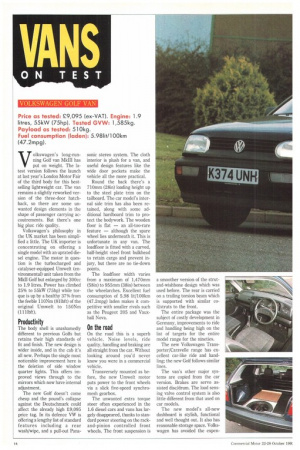VOLKSWAGEN GOLF VAN
Page 20

Page 21

If you've noticed an error in this article please click here to report it so we can fix it.
Price as tested: 29,095 (ex-VAT). Engine: 1.9 litres, 55kW (75hp). Tested GVW: 1,585kg. Payload as tested: 510kg.
Fuel consumption (laden): 5.9814/100km (47.2mpg).
Volkswagen's long-running Golf van MkIII has put on weight. The latest version follows the launch at last year's London Motor Fair of the third body for this bestselling lightweight car. The van remains a slightly reworked version of the three-door hatchback, so there are some unwanted design elements in the shape of passenger carrying accoutrements. But there's one big plus: ride quality.
Volkswagen's philosophy in the UK market has been simplified a little. The UK importer is concentrating on offering a single model with an uprated diesel engine. The motor in question is the turbocharged and catalyser-equipped Umwelt (environmental) unit taken from the Mk11 Golf but enlarged by 300cc to 1.9 litres. Power has climbed 25% to 55kW (75hp) while torque is up by a healthy 37% from the feeble 110Nm (811bft) of the original Umwelt to 150Nm (1111bft).
Productivity
The body shell is unashamedly different to previous Golfs but retains their high standards of fit and finish. The new design is wider inside, and in the cab it's all new. Perhaps the single most noticeable improvement here is the deletion of side window quarter lights. This offers improved views through to the mirrors which now have internal adjustment.
The new Golf doesn't come cheap and the pound's collapse against the Deutschmark could affect the already high Z9,095 price tag. In its defence VW is offering a lengthy list of standard features including a rear wash/wipe, and a pull-out Pana sonic stereo system. The cloth interior is plush for a van, and useful design features like the wide door pockets make the vehicle all the more practical.
Round the back there's a 710mm (28in) loading height up to the steel plate trim on the tailboard. The car model's internal side trim has also been retained, along with some additional hardboard trim to protect the bodywork. The wooden floor is flat — an all-too-rare feature — although the spare wheel lies underneath it. This is unfortunate in any van. The loadfloor is fitted with a curved, half-height steel front bulkhead to retain cargo and prevent injury, but there are no tie-down points.
The loadfloor width varies from a maximum of 1,470mm (58in) to 955mm (38in) between the wheelarches. Excellent fuel consumption of 5.98 lit/100km (47.2mpg) laden makes it competitive with smaller rivals such as the Peugeot 205 and Vauxhall Nova.
On the road
On the road this is a superb vehicle. Noise levels, ride quality, handling and braking are all straight from the car. Without looking around you'd never know you were in a commercial vehicle.
Transversely mounted as before, the new Umwelt motor puts power to the front wheels via a slick five-speed synchromesh gearbox.
The unwanted extra torque steer often experienced in the 1.6 diesel cars and vans has largely disappeared, thanks to standard power steering on the rackand-pinion controlled front wheels. The front suspension is a smoother version of the strutand-wishbone design which was used before. The rear is carried on a trailing torsion beam which is supported with similar coil/struts to the front.
The entire package was the subject of costly development in Germany, improvements to ride and handling being high on the list of targets for the entire model range for the nineties.
The new Volkswagen Transporter/Caravelle range has excellent car-like ride and handling; the new Golf follows similar lines.
The van's other major systems are copied from the car version. Brakes are servo assisted disc/drum. The load sensing valve control system is also little different from that used on car models.
The new model's all-new dashboard is stylish, functional and well thought out. It also has reasonable storage space. Volkswagen has avoided the expen
sive vinyl trim options more often offered in car-derived vans such as the Renault Extra. These mostly appear in the cheaper Ted models, but have high manufacturing costs due to a relatively low take-up.
Summary The Golf is especially pleasant at high speed thanks to car-like standards of noise and vibration. Round town, too, the Golf offers superb driving refinement. The high torque engine allows it to lug its way through any town centre with minimal gearchang ing. This 'automatic transmission' quality really works well when searching for street names and darting in and out of moving traffic.
The standard one-year, unlimited distance warranty is offered, and 12 and 24-month additional option warranties are also available through the dealer.
The body has a six-year anticorrosion warranty and a threeyear paint guarantee. This and the corrosion plan are subject to dealer inspection and the other usual requirements.
Servicing intervals for the diesel-powered model are set at 8,0001m (5,000 miles) for lubrication, with the major service due at 32,000km (20,000 miles) or 12 months, whichever comes first.
A petrol driven option of this model is available on special order, and for this the lubrication service only comes every 16,000km (10,000 miles).
0 by Danny Coughlan












































































